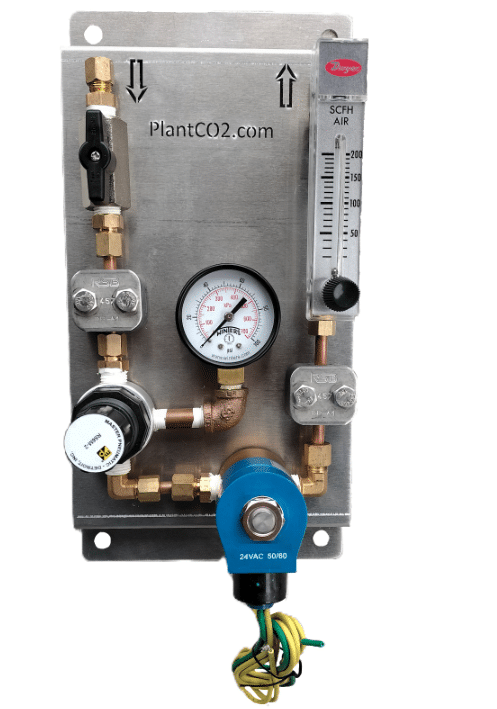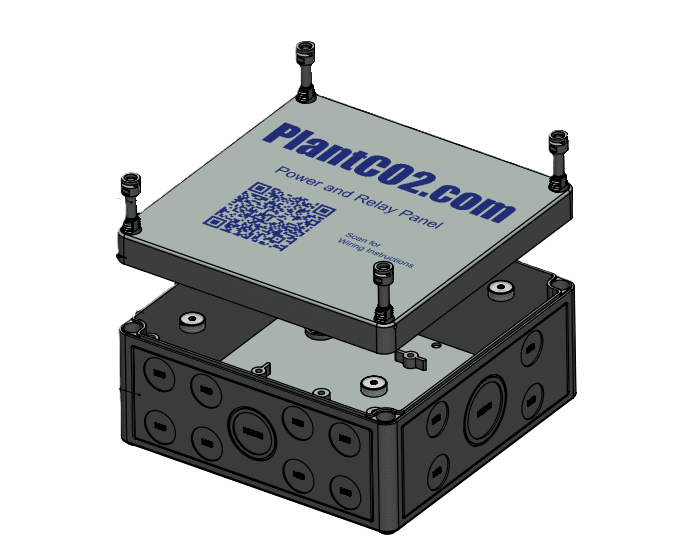The Co2 Advantage
Providing elevated levels of CO2 to almost all plants can unlock a 20-30% increase in growth assuming this is the only limiting factor. If you’re interested in learning more about how plants utilize CO2 check out this well-done article from Grow Glide. PlantCO2.com offers free engineering and design for CO2 systems to ensure that the best practices and recommendations below are implemented at your facility.
Where Science and Art Merge in Cannabis Cultivation
Embarking on the journey of optimizing CO2 systems for cannabis cultivation is akin to delving into a realm where science meets artistry. For many cultivators, the relationship with CO2 begins as curious experimentation, navigating the intricacies of parts per million (PPM), tinkering with solenoids and release apparatuses, and even integrating it into integrated pest management (IPM) strategies. It’s a labor of love, driven by one ultimate pursuit.
The allure of CO2 lies in its transformative power. It’s the catalyst for accelerated growth and amplified yields, turning aspirations into tangible harvests. But why does CO2 hold such sway over plant development? The answer lies in the fundamental principles of biology. Enhanced gas exchange at the stomata facilitates swifter consumption and conversion within the plant, igniting a cascade of metabolic activity that fuels exponential growth.
Moreover, the correlation between CO2 uptake and yield is unequivocal. Carbon, the building block of plant life, forms the backbone of this symbiotic relationship. More CO2 uptake translates directly to increased biomass, culminating in bountiful harvests that exceed expectations.
If these revelations are not novel to you, then you’re poised to delve deeper into the intricacies of CO2 system design, implementation, and operation. In collaboration with David Goodnack of PlantCO2.com, Grow Glide ventures to illuminate the path toward optimal CO2 utilization. With a wealth of insights and expertise at our disposal, we’re committed to empowering cultivators with the knowledge needed to navigate this terrain with confidence.
PlantCO2.com stands as a beacon of guidance, offering complimentary engineering and design services to ensure that industry-leading practices and recommendations are seamlessly integrated into your cultivation facility. Join us as we unravel the complexities of CO2 systems, equipping you with the tools to make informed decisions and unlock the full potential of your cultivation endeavors.
Goals of your CO2 system:
- Evenly distribute CO2 to your plants and elevate the CO2 levels to the Parts per Million (PPM) that fit the type of plant and the stage of life of the plant you’re growing.
- Design a CO2 system that is sized correctly for your room and airflow dynamics or a system that is adjustable to fine-tune once operational.
- Provide a safety system that meets or exceeds the International Fire Code (IFC).
Things to Avoid:
- Purchasing a hobby-grade or grow tent-sized CO2 regulator and solenoid for your commercial system. Most of these regulators max out at 17 SCFH while even the smallest commercial rooms require 50+ SCFH flowrates.
- Incorrectly sizing your Bulk CO2 storage tank.
- Designing a CO2 safety system that shuts down your entire facility from a nuisance alarm.
- Poor/wasteful distribution of CO2 within your rooms.
Above is a diagram of a simplified commercial CO2 system. We’ll walk through the components starting from the left at the bulk CO2 storage tank.
Bulk Liquid CO2 Storage Tank
The bulk storage tank is responsible for storing at least a month’s worth of liquid CO2 for use at the facility. Bulk tanks can be purchased or rented with almost all facilities renting due to the high upfront cost of the tank. Liquid CO2 tanks will also require a properly sized CO2 vaporizer and or pressure builder unit that warms the CO2 as it rapidly expands from liquid to gas and provides the gas flow rate to the facility without a freezing event. A CO2 regulator will also lower the supply pressure from the tank to roughly 80 – 120 psi as it flows through the building.
NEW CO2 Generator Technology
An alternative to purchasing liquid CO2 and a bulk tank is using the new CO2 generator technology. In areas with low electricity rates, these CO2 generators are a very attractive option that gives you a reliable source of CO2 that eliminates the risk of future nationwide CO2 shortages. These CO2 generators are not CO2 burners.
1 – Tank Safety Shutoff Valve (SSV)
The Tank Safety Shutoff Valve (Tank SSV) is responsible for isolating the entire building from the supply of CO2 if concentrations reach 30,000 PPM (large leak event). This safety measure is reserved for the most critical CO2 alarm to ensure that all CO2-related processes in the facility are only disrupted in an emergency. A Safety CO2 Sensor (indicated by the number 4 on the diagram above) is located in each room. When designing your project, ensure that the Safety Shutoff Valve that you select is rated for the following: The valve Max operating pressure exceeds the pressure downstream of the regulator. Typically this is around 100 PSIG for CO2 distribution within the building. If the valve is located outside the building, ensure the valve can operate within the ambient temperatures expected for your area. The valve can handle the maximum expected flow rate for the CO2 system.
The PlantCO2.com Tank SSV is a 120VAC 1″ shutoff valve rated to operate up to 200 PSIG and rated for temperatures down to -30 F. This valve will cover almost every application. The 120VAC solenoid allows for the required daisy-chaining between all of the rooms to occur without any voltage drop issues. Tank Shutoff valves can be sized for special applications if needed.
2 – Room Safety Shutoff Valve (SSV)
The Room Safety Shutoff Valve (Room SSV) will isolate an individual room if 5,000 ppm levels are reached without disturbing the rest of the facility. A low CO2 alarm of 5,000 PPM is far more common. The same Safety CO2 Sensor indicated by the number 4 on the diagram above is used to operate the trigger of this valve. When designing your project, ensure that the Room Safety Shutoff Valve that you select is rated for the following: The valve MAX operating pressure exceeds the pressure entering the room. This is still the distribution pressure within the building typically around 100 PSIG. The valve can handle the maximum expected flow rate for the CO2 system. The PlantCO2.com Room SSVs are a 24VDC 1/2″ shutoff valve rated to operate up to 150 PSIG. This valve is 24VDC so that it can be operated directly from the Power and Relay Panel in the room. Room Shutoff valves can be sized for special applications if needed.
3 – CO2 Enrichment Manifold
The CO2 Manifold is responsible for precisely dosing CO2 into the cultivation room to maintain a constant CO2 ppm level. As CO2 moves through the CO2 manifold, the pressure is first lowered from 100 PSIG down to typically 40 PSIG. Next, a 24VAC Solenoid valve allows for low-voltage control directly from an automation system. Lastly, the flowmeter allows for fine adjustment of the CO2 flow entering the room. Issues can occur if the pressure and/or flow of CO2 cannot be controlled. When CO2 is dispensed into the room, it takes roughly 5 minutes before environmental sensors measure an increase in CO2. It is essential to have a CO2 flow rate high enough to overcome the leakage of CO2 from the room but slow enough to not overshoot the room ppm setpoint. When designing your project, ensure that the CO2 manifold is engineered for the following: Appropriate flowrates and pressures for a commercial cultivation room.
NOTE: Titan Controls CO2 regulators will not work in commercial applications with flow rates maxing out around 17 SCFH. Even the smallest cultivation rooms will have flow rates of around 50 SCFH with most ranging from 100-200 SCFH The PlantCO2.com CO2 Manifolds are engineered for Commercial CO2 distribution pressures. All parts are selected for specific pressures and flow CVs to ensure precise and repeatable CO2 injection.
4 – CO2 Room Distribution
This is typically done by injecting the CO2 gas into the HVAC supply duct or being dispersed in front of a circulation fan on the wall. This technique uses the most amount of CO2 while trying to fully mix the CO2 into the air. CO2 is about 1.5 times heavier than air and sinks out fairly quickly. Using Growglide’s patented updraft system CO2 can be injected and dispersed at the underside of the canopy. Plants absorb CO2 from the bottom of the leaves and often create microclimates that are in a CO2 deficit without proper airflow. The Updraft airflow system disrupts the microclimates while providing CO2-rich air to the plants. This method can reduce CO2 consumption while increasing the effectiveness of the CO2 for your plants.
5 – CO2 Safety Sensors
The CO2 Safety Sensor is responsible for the life safety in the room. Each room has an independent sensor that is separate from the sensors provided by your cultivation control system. The CO2 Safety Sensor is mounted 12″ above the floor where CO2 is most likely to accumulate. The International Fire Code (IFC) dictates the safety measures that are required in a CO2-enriched room occupied by humans. The IFC requires the following actions to occur:
5,000 PPM
- – Provide an audible and visual alarm inside and outside of the CO2-concentrated room.
- – Isolate the CO2 supply from the space.
- – Turn on the exhaust fan.
- 30,000 PPM
- – Provide an audible and visual alarm inside and outside of the CO2-concentrated room.
- – Isolate the CO2 supply from the space.
- – Turn on the exhaust fan.
PlantCO2 solutions isolate the CO2 supply from the room for the 5,000 PPM alarm and isolate the entire facility at 30,000 PPM.
6 – Power and Relay Panel
The power and relay panel provides power to the CO2 safety sensor(s) and equipment integration inside each room. The power supply creates a hardwired power connection to your CO2 sensor that can’t be removed per the IFC requirements. There are a few solutions on the market that do not meet this requirement and can result in not passing your fire inspection. The relays are provided to control the room safety shutoff valve, integrate with the control system for exhaust fan control, and link all rooms together to control the tank safety shutoff valve, and notify the fire alarm panel of a 30,000 PPM alarm. An additional relay can be included if notification to the fire alarm is also required at 5,000 PPM.
When in doubt, reach out to a specialist to help you design a CO2 solution for your facility. Free CO2 designs are offered by PlantCO2 by filling out the form here.



















Leave A Comment